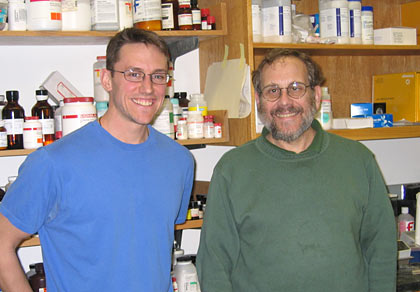Authors Michael Fox (left) and Josh Sanes
The synapse is the heart of the nervous system, the site at which information is processed and passed between cells. Proper functioning of the synapse requires precisely aligned pre- and postsynaptic specializations, for sending and receiving the synaptic signal, respectively. This arrangement suggests that developmentally relevant signals, as a kind of information processing, are exchanged by pre- and postsynaptic cells to assure properly coordinated differentiation. Many labs, including Sanes’, have used cell culture assays to identify the factors involved. On just the presynaptic terminal over a dozen molecules have been identified which, when applied to cultured neurons, are capable of promoting at least some steps in the transformation of neurites into functional nerve terminals.
This embarrassment of riches has led to a new question, which Fox et al. have now addressed: Do organizers of differentiation with similar effects in vitro play distinct roles in vivo? Several possibilities present themselves. One possibility is that different synapses use different organizers in vivo, even though each is capable of affecting a variety of neuronal types in vitro. Or, different organizers might promote distinct aspects of differentiation such as recruitment of ion channels or clustering of synaptic vesicles. A third possibility is that multiple organizers could act combinatorially, allowing fine control of synaptogenesis. Fourth, organizers may act sequentially, with different molecules regulating the initial development, subsequent maturation and dynamic maintenance of the synapse. Fifth, some factors capable of promoting presynaptic differentiation in culture may have different functions in vivo, such as regulation of synaptic efficacy. Clearly, many other possibilities exist.
Using the neuromuscular junction, an accessible, peripheral synapse between a motoneuron and a muscle fiber, Fox et al. found one explanation for the multiplicity of signals: they act sequentially at distinct developmental stages to pattern the nerve terminal. The researchers made use of a set of targeted mouse mutants that disrupted signaling of three sets of presynaptic organizers: fibroblast growth factors (FGFs), ß2-laminins and collagens IV. All were necessary for the proper motor nerve terminal assembly in vivo, but at different stages: FGFs and collagen a1/2 (IV) chains acted in embryonic and perinatal muscle to direct the initial differentiation of nerve terminals; ß2 laminins were required in early postnatal synapses to promote their maturation; and collagen a3-6 (IV) chains were required for long-term maintenance after synapses had matured. Thus, these families of target-derived organizers act sequentially, separately affecting the formation, maturation and maintenance of motor nerve terminals.
Based on this work, the investigators now plan to ask similar questions about the more interesting but less accessible synapse of the brain. In addition, they have already started to ask whether alterations in any of these signaling systems are responsible for the synaptic deficiencies that accumulate as animals age.
Article title: Distinct Target-Derived Signals Organize Formation, Maturation, and Maintenance of Motor Nerve Terminals


